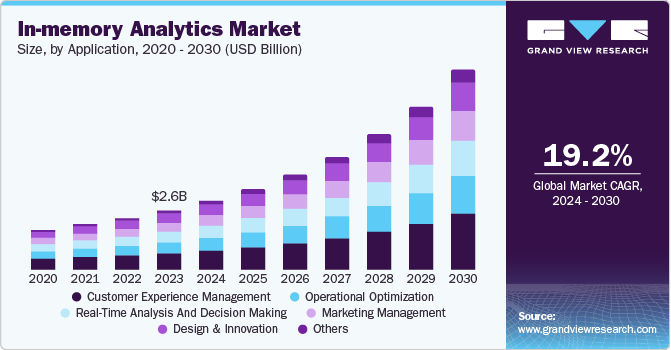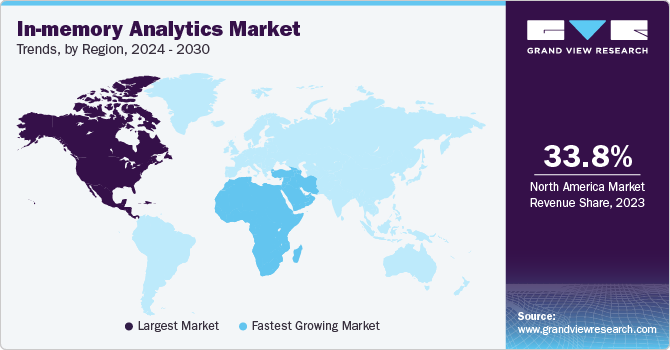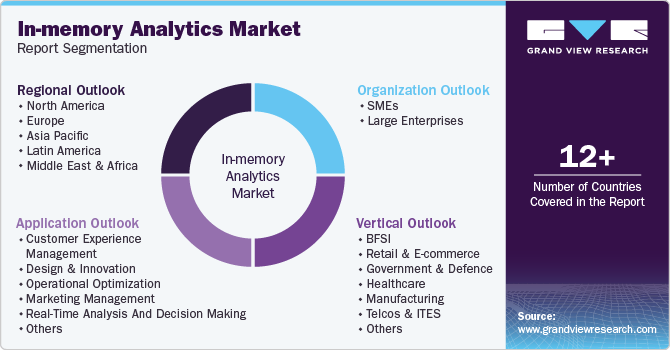
In-memory Analytics Market Size, Share & Trends Analysis Report By Application By Organization Size (SMEs, Large Enterprises), By Vertical, By Region, And Segment Forecasts, 2024 - 2030
- Report ID: GVR-2-68038-048-4
- Number of Report Pages: 100
- Format: PDF
- Historical Range: 2018 - 2022
- Forecast Period: 2024 - 2030
- Industry: Technology
In-memory Analytics Market Size & Trends
The global in-memory analytics market size was valued at USD 2.60 billion in 2023 and is projected to grow at a CAGR of 19.2% from 2024 to 2030. Growth of this market is primarily driven by the factors such as emergence of high-performance memory technologies such as persistent memory, increasing digital transformation activities in multiple industries, rise in use of real-time analytics in business processes and growing trend of data-driven organization culture worldwide.

Significant performance improvement and the increasing demand for real-time insights drive the adoption of in-memory data analytics in healthcare, finance, retail, and manufacturing organizations. Moreover, in-memory analytics' ability to handle complex queries and perform advanced analytics on large volumes of data sets it apart from traditional database systems. This enhanced data processing capability is crucial for organizations seeking valuable insights from their data for quick, informed decision-making.
In-memory analytics platforms offer scalability and flexibility, which allows organizations to expand their analytical capabilities as their data requirements grow. In addition, in-memory analytics helps in real-time data analysis by providing instant access to up-to-date information stored in memory. Traditional processes using data stored in a storage disk take more time than in-memory analytics, increasing the adoption rate of the in-memory analytics system. While in-memory analytics solutions require higher initial investments than traditional disk-based systems, they often prove to be cost-effective due to improved performance, reduced maintenance costs, and increased productivity resulting from faster data processing.
Organization Size Insights
The large enterprises segment dominated the industry and accounted for a revenue share of 80.1% in 2023. In-memory analytics requires significant investment in powerful hardware with large RAM capacities. This high initial cost becomes a barrier for smaller businesses with limited budgets and resources at hand. Large enterprises have the resources to allocate towards such infrastructure. In addition, large enterprises often deal with large databases containing various data. Traditional disk-based analytics can struggle with increasing complexity, while in-memory handles such data, ensuring faster and more efficient data processing.
The SME segment is expected to grow at the fastest CAGR from 2024 to 2030. This growth is attributed to SMEs' growing business needs. SMEs are increasingly recognizing the value of data-driven decision-making in order to compete effectively. In-memory analytics enables faster, real-time insights that inform strategic planning, resource allocation, and customer relationship management. Cloud-based solutions, decreasing RAM costs, and user-friendly software are lowering barriers for SMEs and increasing the adoption of in-memory analytics.
Application Insights
Based on the application, the customer experience management segment held the largest revenue share in 2023. The growth of this segment is mainly driven by the changing nature of businesses and industries, including retail, telecom, e-commerce, healthcare, and others. Companies have been focusing on delivering enhanced portfolios that align with customer requirements. In addition, the demand for continuous customer experience and engagement monitoring has resulted in rising dependency on real-time data insights assisted by in-memory analytics. Changing consumer behavior changes businesses' strategies to provide personalized customer experiences. In a competitive landscape, in-memory analytics processes massive datasets with high velocity, containing customer behavior, sentiment, and interaction data. It allows businesses to gain immediate insights and tailor offerings, promotions, or support interactions to individual customers.
The real-time analysis and decision-making segment is expected to grow at a significant CAGR during the forecast period. Business environments are becoming increasingly competitive and dynamic, which increases the need to make data-driven decisions quickly to capitalize on opportunities or mitigate potential risks. Real-time analytics helps businesses adapt to market changes, changing customer behavior or competition. Real-time insights allow companies to identify inefficiencies or bottlenecks in operations, leading firms to optimize productivity and cost reduction processes. Advancements in technology, Internet of Things (IoT) devices, and high bandwidth networks are generating real-time data faster. Memory analytics helps process and analyze this vast amount of data, providing real-time actionable insights.
Vertical Insights
The BFSI segment dominated the global industry in 2023. BFSI institutions deal with massive amounts of data, including transaction records, customer information, and financial instrument data. Fraudulent activity can cost financial institutions significant sums. In-memory analytics facilitates real-time analysis of transaction patterns, enabling the identification of potential fraud attempts. In-memory analytics empowers banks and insurance companies to personalize customer service by analyzing real-time customer data and interaction history. This enables them to tailor product recommendations, offer targeted financial solutions, and provide faster and more efficient customer support. The BFSI industry has been using in-memory analytics to deliver personalized experiences, identify risks, streamline business operations, and ensure regulatory compliance.

The healthcare segment is expected to grow at the fastest CAGR during the forecast period. The adoption of in-memory analytics in healthcare is driven by its unique requirements for real-time insights, personalized care delivery, regulatory compliance, operational efficiency gains, and enhanced patient outcomes. The healthcare industry generates vast amounts of data daily, including patient records, medical imaging, genomic data, and operational information. In-memory analytics is efficient in predictive capabilities, increasing its importance in preventative care and disease management. Analyzing historical data and identifying patterns provides crucial insights into patient health and helps in treatment decision-making.
Regional Insights
North America dominated the global in-memory analytics market and accounted for revenue share of 33.8% in 2023. Higher pace of digital transformations in the industry, growing emphasis on data driven strategy determination and implementation, increasing adoption of data analytics for real-time insights and enhanced service delivery have driven growth of this market. Robust IT infrastructure in the region, presence of multiple large enterprises operating in multiple industries, and higher dependency on data availability are expected to influence growth of this industry in approaching years.

U.S. In-memory Analytics Market Trends
The U.S. in-memory analytics market dominated the regional industry in 2023. This market is mainly driven by factors such as highly developed digital infrastructure, widespread adoption of technologies such as cloud computing and the Internet of Things (IoT) and rapid digital transformations. This digital readiness provides a strong foundation for implementing and integrating in-memory analytics technology. Businesses in the U.S. are highly focused on optimizing operations and reducing costs. In-memory analytics offer solutions that address these needs, propelling market growth.
Europe In-memory Analytics Market Trends
Europe in-memory analytics market was identified as a lucrative region in 2023. This is attributed to factors such as this growing adoption of big data and AI, strong emphasis on data privacy & security, and increasing focus on operational efficiency and cost optimization. Europe has strict data privacy and security regulations, such as the General Data Protection Regulation (GDPR), considered the toughest data protection law in the world. These factors emphasize the use of efficient and safe data systems.
Germany in-memory analytics market held a substantial revenue share in 2023. This market is mainly driven by the aspects such as presence of robust manufacturing industry in the country, growing adoption of in-memory analytics by various verticals, accessibility and availability of multiple analytics solutions, entry of multiple key companies from technology and innovation industry in Germany and rising need for real-time data analysis and insights in numerous businesses.
Middle East & Africa In-Memory Analytics Market Trends
In-memory analytics market in MEA is projected to experience the fastest CAGR from 2024 to 2030. The exponential growth of data generated by businesses in the region is one of the primary drivers for the increasing adoption of in-memory analytics. Traditional analytics solutions struggle to process and analyze large volumes of data efficiently, leading organizations to turn to in-memory analytics for real-time processing capabilities. Industries in the region, such as healthcare, BFSI, and others, have relied on analytics solutions to make strategic decisions and improve customer experience.
The UAE in-memory analytics market held a significant share in 2023. This is attributed to internet penetration and favorable government policies that increase investment in the country. According to the World Bank, UAE is one of the top countries in terms of ease of business, which has attracted significant foreign investments and facilities into the country. In addition, increasing reliance on data-driven strategic decision-making, strategy implementation, and customer engagement is expected to drive the growth of this market in the approaching years.
Key In-memory Analytics Company Insights
Some of the key companies in the in-memory analytics market include SAP SE, IBM, Oracle, ActiveViam, Amazon Web Services, Inc., Cloud Software Group, Inc., and others. To address the growing demand and increasing completion in the industry, major players in market are adopting strategies such as enhanced portfolios, advancements in technology offerings, growing geographical presence and partnership with other organizations.
-
SAP SE, one of the prominent companies in the technology and innovation industry, offers high-quality in-memory computing technologies to multiple businesses operating in different verticals. SAP’s HANA (High-performance Analytics Appliance), a modern solution associated with in-memory analytics, is used by numerous users worldwide.
-
Oracle, the major software technology and innovation industry participant, offers multiple solutions related to modern in-memory analytics technology. The Oracle Exalytics In-Memory Machine, equipped with the company’s business intelligence foundation suite and TimesTen in-memory database, delivers high-performance analytics and insights.
Key In-memory Analytics Companies:
The following are the leading companies in the in-memory analytics market. These companies collectively hold the largest market share and dictate industry trends.
- SAP SE
- IBM
- Oracle
- ActiveViam
- Amazon Web Services, Inc.
- Cloud Software Group, Inc.
- MicroStrategy Incorporated
- SAS Institute Inc.
- Software AG (Mosel Bidco AG)
- Exasol
Recent Developments
-
In November 2023, Amazon Web Services, Inc. launched the EC2 high memory U7i Instances, with custom 4th Generation scalable processors Intel’s Xeon to complete the market demand for efficient data processing. These instances facilitate memory-intensive workloads such as real-time big data analytics for in-memory databases.
In-Memory Analytics Market Report Scope
|
Report Attribute |
Details |
|
Market size value in 2024 |
USD 3.01 billion |
|
Revenue forecast in 2030 |
USD 8.66 billion |
|
Growth Rate |
CAGR of 19.2% from 2024 to 2030 |
|
Base year for estimation |
2023 |
|
Historical data |
2018 - 2022 |
|
Forecast period |
2024 - 2030 |
|
Quantitative units |
Revenue in USD million and CAGR from 2024 to 2030 |
|
Report coverage |
Revenue forecast, company ranking, competitive landscape, growth factors, and trends |
|
Segments covered |
Organization size, application, vertical, and region |
|
Regional scope |
North America, Europe, Asia Pacific, Latin America, MEA |
|
Country scope |
U.S., Canada, Mexico, Germany, UK, France, China, Japan, India, Australia, South Korea, Brazil, South Africa, UAE, and South Africa. |
|
Key companies profiled |
SAP SE; IBM; Oracle; ActiveViam; Amazon Web Services, Inc.; Cloud Software Group, Inc.; MicroStrategy Incorporated; SAS Institute Inc.; Software AG (Mosel Bidco AG); Exasol |
|
Customization scope |
Free report customization (equivalent up to 8 analysts' working days) with purchase. Addition or alteration to country, regional & segment scope. |
|
Pricing and purchase options |
Avail customized purchase options to meet your exact research needs. Explore purchase options |
Global In-memory Analytics Market Report Segmentation
This report forecasts revenue growth at global, regional, and country levels and provides an analysis of the latest industry trends in each of the sub-segments from 2018 to 2030. For this study, Grand View Research has segmented the in-memory analytics market report based on application, organization size, vertical, and region.

-
Organization Size Outlook (Revenue, USD Million, 2018 - 2030)
-
SMEs
-
Large Enterprises
-
-
Application Outlook (Revenue, USD Million, 2018 - 2030)
-
Customer Experience Management
-
Design & Innovation
-
Operational Optimization
-
Marketing Management
-
Real-Time Analysis And Decision Making
-
Others
-
-
Vertical Outlook (Revenue, USD Million, 2018 - 2030)
-
BFSI
-
Retail & E-commerce
-
Government & Defence
-
Healthcare
-
Manufacturing
-
Telcos & ITES
-
Others
-
-
Regional Outlook (Revenue, USD Million; 2018 - 2030)
-
North America
-
U.S.
-
Canada
-
Mexico
-
-
Europe
-
UK
-
Germany
-
France
-
-
Asia Pacific
-
China
-
Japan
-
India
-
Australia
-
South Korea
-
-
Latin America
-
Brazil
-
-
Middle East & Africa (MEA)
-
South Africa
-
Saudi Arabia
-
UAE
-
-
We are committed towards customer satisfaction, and quality service.
"The quality of research they have done for us has been excellent."




